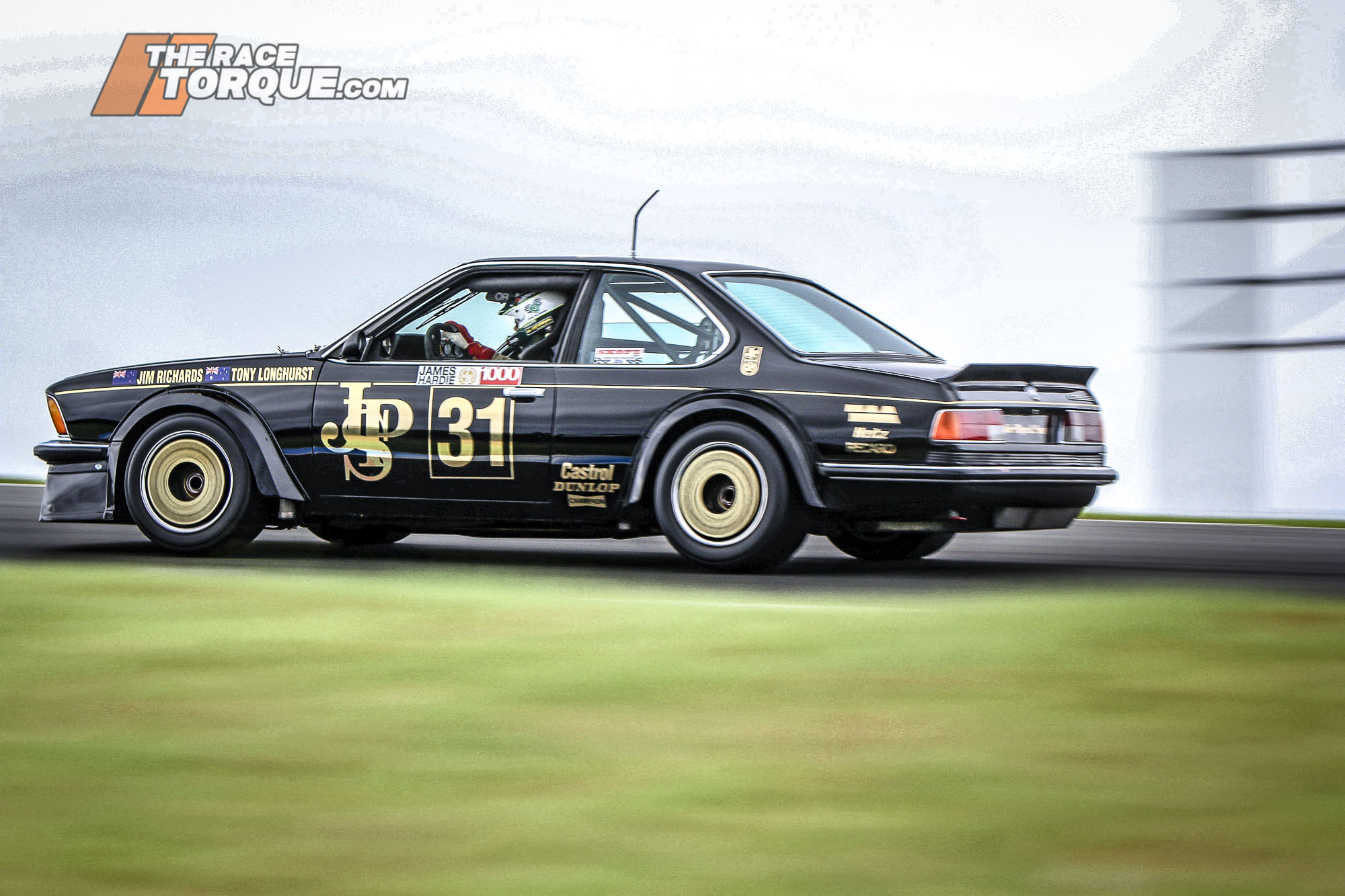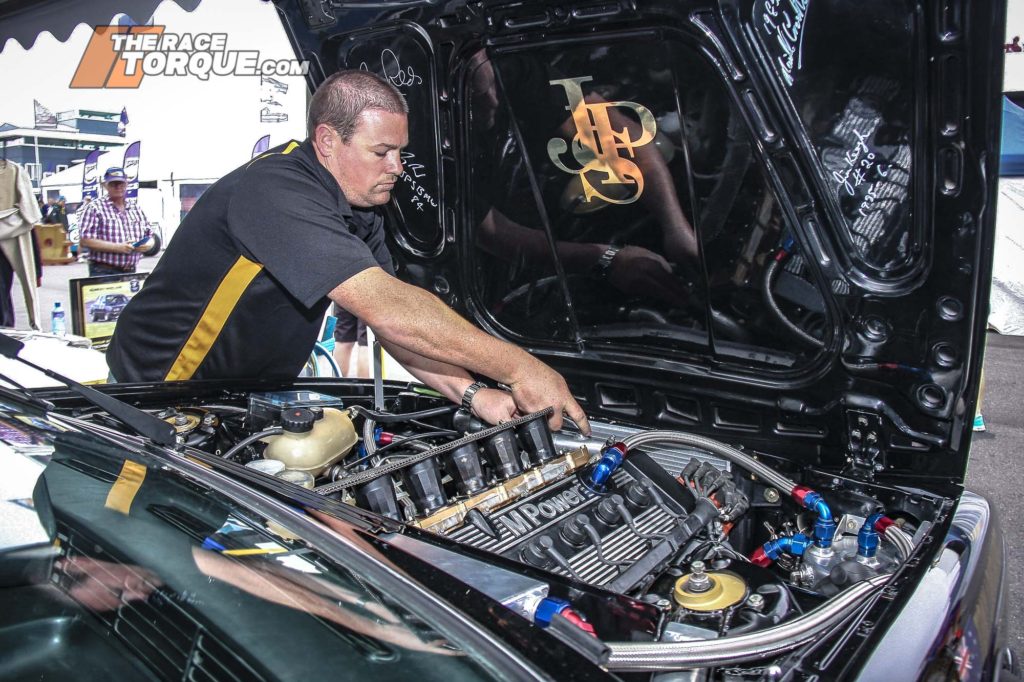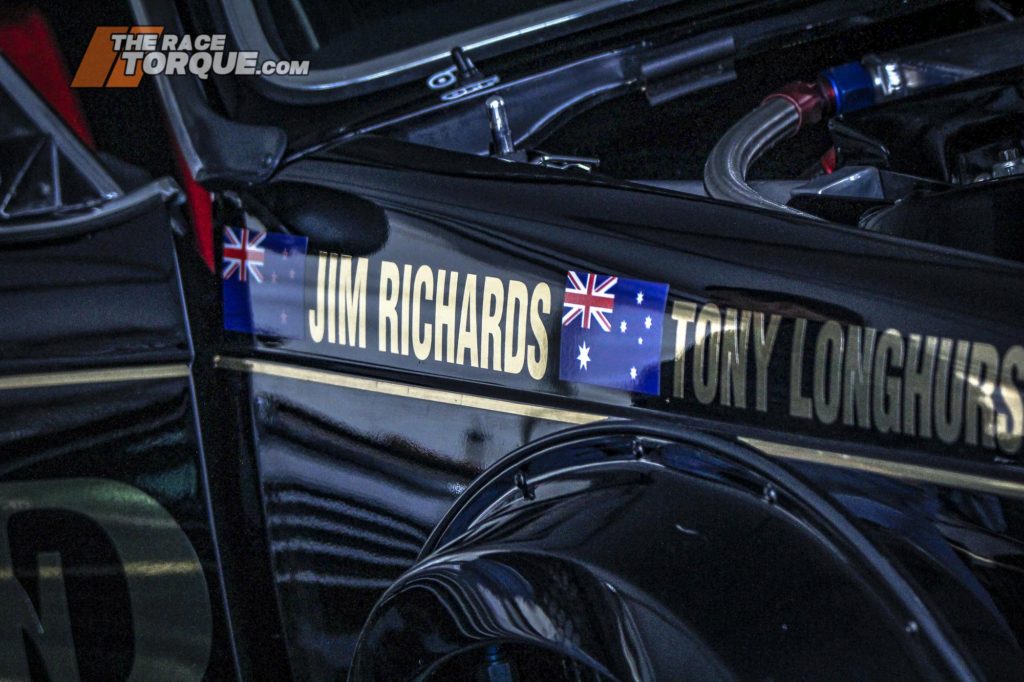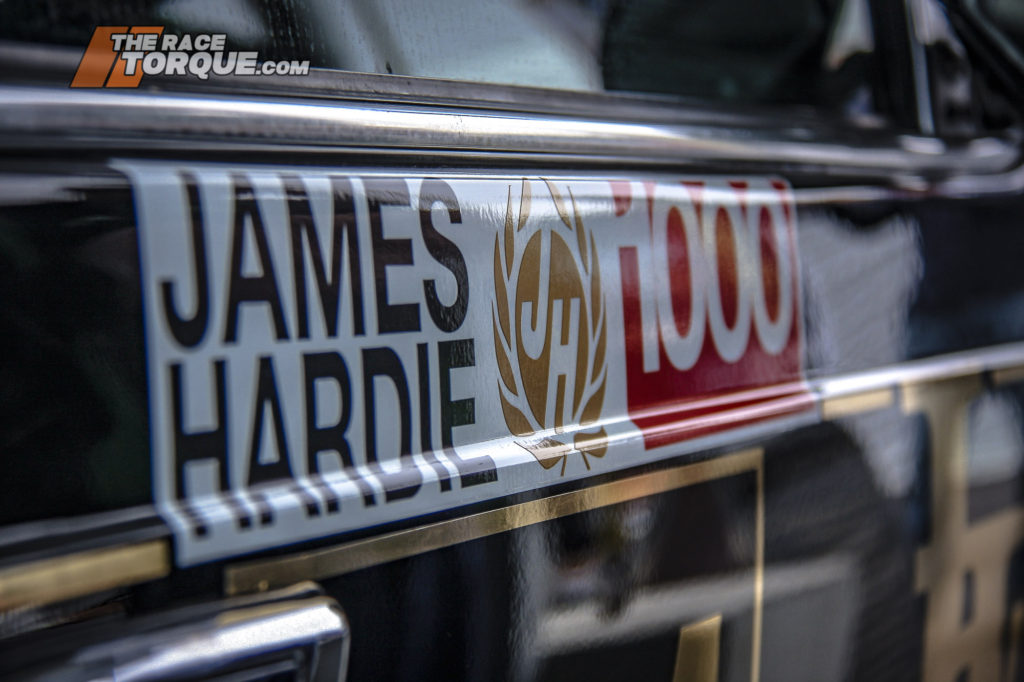UP CLOSE: Bathurst Sabotage & A Life Beyond Group C

In the opening segment of our two-part special on the Group C BMW 635CSis, we looked at the politics of the era, the development of the Black Beauties, plus the fact the second car almost never actually happened…
You can check it out right here.
Sabotage
After an extended spell on the bench in 1983, the saviour for the Group C BMW 635CSi would come in the form of the twin-cam, 24 valve cylinder head (as first found in the M1 supercar), which would lift the car’s output to 390hp, bringing it in line with the Commodores.
The car also received adapted and adjustable Group A suspension, as well as bigger wheels and tyres, complete with centre lock hubs.
All told for the JPS equip, the 22 BBS wheels came in at about $10,000, and with the larger rattle guns $500 a pop, the whole exercise ran to around $13,000 in ’83 money.
The car however was still hamstrung by limited transmission and axle ratios, which made life somewhat difficult with the exception of Bathurst, and in the suite of upgrades, it didn’t receive the full M1 fuel system to compliment the cylinder head.
The 635CSi was finally in the conversation and was looking sharp on debut at Amaroo Park’s enduro, when surprisingly, the handling dropped off late in the run, crossing the line fifth.
The car was also delayed in the Oran Park endurance round with a broken McPherson strut.
Meanwhile, at the Sandown 400, a weekend where Mazda controversially received fuel injection for its 13B rotary, and protests flew in every direction bar BMW’s, Richards forged into the lead of the race before eventually finishing second to Allan Moffat’s RX7.
BMW was in the game, and the preliminaries at Mount Panorama also had the competition worried.
As fast as anyone down the chute (the car was clocked at 260km/h on Conrod Straight), Richards parked it on the outside of the second row of the grid in Hardies Heroes, with team manager Frank Gardner on board for the lunchtime stint on Sunday.
For Gardner, who retired from racing following his win in the 1977 Australian Sports Sedan Championship, it would be his last major race start, although the former F1 driver and multiple British Saloon Car champion did continue to undertake the bulk of the development work on the Group C BMWs at Amaroo Park.
He would continue that task into the Group A M3 days.
Black Beauty was indeed a dark horse in The Great Race, with the outfit also claiming the best-presented car award.
Uniquely for the event, the entry carried a submarine periscope-styled Channel 7 Raceview camera in the front passenger seat, which poked up through the roof (a hole that makes the car easy to identify to this day), although it had very limited use on race day.
While holding down third on the opening lap, disaster struck for Richards, with the car misfiring, before grinding to a halt in the pits after only a handful of circuits.
Quick examinations by the crew found contaminants in the injectors, metal shavings and sand.
How it got there is anybody’s guess, but the instant scuttlebutt suggested sabotage.
Who and how, nobody was ever able to answer, although there was supposed to be security in place overnight.
That said, Bill Tuckey in his excellent official recount of the event noted that he walked straight into an unguarded JPS tent late the previous night.
Keep in mind too, that particular evening, the backlots of pit straight were alive with the miracle re-birth of Greens Tuf following Dick Johnson’s earlier journey into Forrest’s Elbow’s foliage, so there were plenty of people lurking around.
The following year, throughout the pit lane, security was to be a top priority.
Potential reasoning behind any malicious intent was speculated; from the Euro aspect of the team to its cigarette backing, but none of the conspiracies made any particular sense.
The truth is out there…
Frank Gardner and Peter Wherrett discuss the dirty fuel in the pits, Bathurst 1983
The subsequent endurance races that year held on tighter tracks, or in the case of Surfers Paradise International, a configuration that featured numerous long, loaded turns, saw handling issues continue to haunt the car, which continued to burn up its tyres.
It was a complicated scenario – much of the engine’s weight was forward of the front axle, and the new-spec engine itself was heavier, to the tune of 28kg.
Amplifying issues, the additional 80-odd horsepower placed more emphasis on handling, while the category’s minimum ride height rules made the problems challenging to tune out, especially on cross-ply tyres.
Richards revealed in recent times to Auto Action’s Mark Fogarty that Gardner attempted to adjust the imbalance out of the car by packing lead inside the rear bumper…
Seventh at Surfers Paradise was followed by sixth at Adelaide International, while Richards placed fourth in the Australian Grand Prix support race at Calder Park.
By virtue of presenting at all of the rounds, Richards finished second in the Endurance Championship to RX7 pilot Peter McLeod.
The 1984 season dawned, with Richards committing to his first full Australian Touring Car Championship campaign, even though by this stage he had already won three of his eventual seven Bathurst 1000 crowns.
While the car was quick in qualifying, the sensitivity of each track to tyre wear would determine its fate: the old big bad Sandown saw a fourth, same for Lakeside (from pole, which was earned on a damp track), and a wet Surfers Paradise round resulted in a third. Wanneroo, on the other hand, provided an eighth-place finish and Adelaide International seventh.
A first lap biff at Oran Park relegated the BMW out of the points, and a snapped half shaft at Symmons Plains resulted in a DNF; the car’s five-speed Getrag transmission was staunch, but as typical in Group C racers, the other components of the driveline were susceptible to failure.
Richards wound up fifth in the final championship run down, and elsewhere, he finished third in the AMSCAR Series through sheer consistency.
A best race result of second was backed up by five third-place finishes, and 11 top-fives from the 12 heats contested at Amaroo Park.
While the Ford and Holdens extracted the most out of the rules set for the season, Richards was looking strong in enduro trim and led handsomely at Amaroo before another driveline failure.
Third at Oran Park was followed by a diff failure at Sandown, the first major race held on the new, tighter, international grade configuration, which proved to be an extreme test of reliability.
After qualifying sixth a Bathurst, a couple of seconds faster than the team’s previous best effort, Richards, who was paired with Tony Longhurst, was an early retirement due to engine woes.
Much of the team’s attention in the lead up to race day was devoted to repairing the team’s Group A car, which was significantly shortened on Wednesday in the Esses by Prince Leopold von Bayern, who was sharing driving duties with Denny Hulme.
The Prince, otherwise known by his official title, Leopold Rupprecht Ludwig Ferdinand Adalbert Friedrich Maria et omnes sancti Prinz von Bayern, would go on to race extensively in the DTM, and return to Australia in 1987 to race at the Calder Park World Touring Car Championship round.
And that was it for the Group C BMWs, with the squad parking the big banger in favour of the Group A machine for Australian Grand Prix support races at Calder.
Ultimately, the model would never win a major race under the Group C regulations, although Richards was just getting started…
Neville Crichton passes Alan Jones for second place at Winton.
From C to A
For the start of the Group A regulations, the Group C 635CSi was one of the limited examples which were converted for the new-era specifications.
Awaiting shipment of his own car, Neville Crichton took the wheel of the former Group C machine for the first event of the 1985 season at Winton, where he claimed second to Richards, who campaigned the car shunted by the Prince the previous October.
In Group A trim, with about 120 less horsepower, the lower, lighter package meant that the balance simply worked, and with the years of development under the team’s collective belt, plus early familiarity with the new specs, paid dividends handsomely.
Richards would go on to win seven of the ten races in ’85 to claim his first of four Australian Touring Car Championships, also winning the Endurance Championship and AMSCAR Series in the same year.
All in all, Richards was victorious in 17 of the 21 races he started.
After the opening round, the ex-Group C car passed through the hands of Glenn Molloy, who raced the car in the AMSCAR series, before being sold to Melbourne solicitor Jim Keogh, who ditched his largely uncompetitive VK Commodore.
With prep provided by John Sheppard, the car now decked out in a smart maroon and silvery Kass Car Rental livery headed to Sandown and Mount Panorama for its fourth enduro campaign, with Garry Rogers signed on as co-pilot.
The combination registered a DNF at Sandown after 39 laps with a loose flywheel and a CV joint failure, but they were running in sixth at that point, with the entry carrying ABC’s Racecam for the event.
With minimal contingencies in place (it was reported that for Sandown the team only had a spare fan belt), practice laps were kept in check at Bathurst.
During the race, Keogh survived a lurid spin through McPhillamy Park, while a miscalculation on fuel saw the car run dry with two laps to go while on top of the Mountain.
Still, a sixth-place finish was a respectable result for the privateer effort.
Keogh retained the machine for ’86, with the New Zealand long-distance races at Wellington and Pukekohe resulting in DNFs for him and local co-driver Struan Robertson.
The car then finished ninth in Sandown ATCC round, before Keogh teamed with Des Wall for the enduros.
After finishing 25th at Sandown, their run was short-lived at Bathurst, with the car snapping a throttle cable after 30 circuits, with the improvised solution leading to a fried clutch and retirement.
The car was then purchased by Peter Hudson, who with Ian Carrig and Ian Clark raced it to tenth in the 1989 Pepsi 300 at Oran Park, non-classified and a DNF in the respective 1989 and ’90 Sandown 500s, with Carrig also steering it to 23rd in the 1990 ATCC round at Phillip Island.
The Next Life
The car then appears to have relocated to New Zealand in 1991, with Jim Boult restoring it to its short-lived JPS Group A livery, before it was snapped up by its current custodian Peter Sturgeon.
Reunited with Richards, the car returned to the track in Group A spec for the Phillip Island Classic and the historic tourer support races at the Albert Park in 2012.
Richards and former JPS chief spanner Pip Barker then convinced Sturgeon to undertake a two-year-long rebuild to see the car return to the track in Group C configuration, which debuted at the 2015 Adelaide Motorsport Festival.
It has subsequently raced extensively on the historic scene, both throughout Australia at events such as the Phillip Island Classic, the Muscle Car Masters at Sydney Motorsport Park, the Silverstone Classic in 2017, where it won the Most Admired Car Award, at the Nurburgring, plus in various meets in New Zealand amongst others.
Both of the black beauties continue to attract attention whenever they run.
















